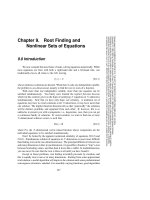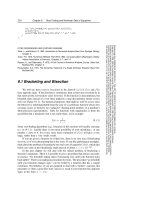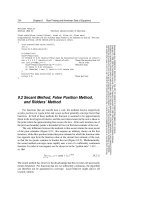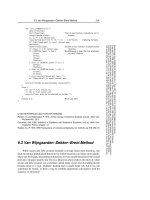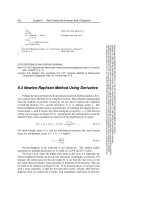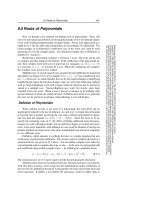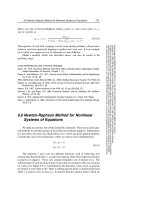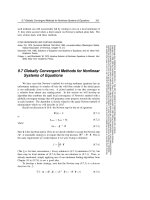Finding unique selling proposition of UH-HSB executive MBA program
Bạn đang xem bản rút gọn của tài liệu. Xem và tải ngay bản đầy đủ của tài liệu tại đây (20.97 MB, 63 trang )
VIETNAM NATIONAL UNIVERSITY
HANOI SCHOOL OF BUSINESS
TA NGOC DIEP
FINDING UNIQUE SELLING PROPOSITION OF
UH-HSB EXECUTIVE MBA PROGRAM
M ajor: Business A dm inistration
Code:
MASTER OF BUSINESS ADMINISTRATION THESIS
SUPERVISOR: ROGER FORD
HANOI, 2004
ABSTRACT i
TÓ M T Ắ T ii
ACKNOWLEDGMENTS iii
TABLE OF CONTENTS iv
LIST OF TABLES VII
LIST OF IL LU STRA T IO N S viii
LIST OF ABBREVIATIO N S ix
INTRODUCTION 1
1. Reason to choose this thesis 1
2. Objective o f the research 1
3. Content o f the research 2
4. M ethodology 2
5. Scale o f the research 2
CHAPTER 1: ABOUT UNIQUE SELLING PRO POSITIO N 4
1.1. What is Ư SP? 4
1.2. Categories of U S P
6
1.2.1. Low Price 6
1.2.2. High Quality 6
1.2.3. Superior Service 7
1.2.4. Size/ Selection 7
1.2.5. C onvenience 8
1.2.6. Knowledgeable, Recognized Authority 8
1.2.7. Customization/ Most O ption 9
1.2.8. Speed 9
TABLE OF CONTENTS
1.2.9. Originality, First in M arketplace 10
1.2.10. Strongest G uarantee 10
1.3. Benefit in developing U SP 11
1.4. How to identify U S P 14
1.5. Promote the U S P 16
CHAPTER 2: APPLY MARKETING RESEARCH IN FINDING OUT USP
2.1. M arketing research 17
2.2. M arketing research process
17
2.3. Apply marketing research to find out U S P 19
CHAPTER 3: FINDING USP OF UH-HSB EMBA PROG R A M 21
3.1. About UH-HSB EMBA program 21
3.2. SWOT analysis 23
3.2.1. S trength 23
3.2.2. W eakness 23
3.2.3. O pportunity 24
3.2.4 T hreat 24
3.3. Competitors 24
3.3.1. W ashington State University 24
3.3.2. Northcentral University 26
3.3.3. AITCV 27
3.3. 4. RMIT Vietnam 27
3.3.5. Conclusion 29
3.4. Consumer analysis 30
3.4.1. Who they are? 36
3.4.2. Their objective when doing MBA 36
3.4.3. The factors affect them to choose the UH-HSB EMBA program
36
3.4.4. Their perception after having UH-HSB EMBA program. 37
3.4.5. The benefit of the M B A 38
CHAPTER 4: RECO M M ENDATION 39
4.1. Some differentiations o f the program
39
4.2. The current slogan of the program 40
4.3. The USP of the program 40
4.3.1. The best differentiation o f program 40
4.3.2. USP o f the UH-HSB EMBA program 41
4.4. How to deliver this USP to the customers 42
CONCLUSION 44
APPENDIX 45
Appendix A 45
Appendix B 55
REFERENCES 56
vi
vii
LIST OF TABLES
Table 3.1: Tuition Fee Comparison 24
Table 3.2: Advantages and Disadvantages Com parison 29
viii
LIST OF ILLUSTRATIONS
Exhibit 3.1: Structure o f VEMBA 1 in term of their organization
.
31
Exhibit 3.2: Structure of VEMBA 1 in term o f their positions
31
Exhibit 3.3: Structure o f VEMBA 2 in term of their organization
.
32
Exhibit 3.4: Structure o f VEMBA 2 in term of their positions
32
Exhibit 3.5: Structure o f VEMBA 3 in term o f their organization
.
33
Exhibit 3.6: Structure o f VEMBA 3 in term of their positions
33
Exhibit 3.7: Compare Structure o f VEMBA 1,2,3 in term of their organization
34
Exhibit 3.8: Com pare Structure o f VEM BA 1,2,3 in term o f their positions
34
Exhibit 3.9: The way of participants get information about the program
35
IX
LIST OF ABBREVIATIONS
AACSB: The Association to Advance Collegiate Schools o f Business
AIT: Asian Institute o f Technology
AITCV: Asian Institute o f Technology Center in Vietnam
CEO: Chief Executive Officers
EMBA: Executive M aster of Business Administration
GMAT: Graduate Management Admission Test
GPA: Grade Point Average
GRE: Graduate Record Examination
HSB: Hanoi school o f Business
HUT: Hanoi University o f Technology
IELTS: International English Language Testing System
JV: Joint-Venture
M BA: Master o f Business Administration
NCU: Northcentral University
NEU: National Economics University
NGOs: Non-Governmental Organizations
RMIT: Royal Melbourne Institute o f Technology
SOE: State Own Enterprise
TOEFL: Test Of English as a Foreign Language
UH: University o f Hawaii
USP: Unique Selling Proposition
VEM BA: Vietnam Executive MBA
WOM: Word of Mouth
WSU: W ashington State University
1
INTRODUCTION
1. R eason to choose this thesis:
Most business executives would have heard the term Unique Selling
Proposition (USP) talked about, often when the subject of sales or marketing comes
up. Very few understand what it really is, what its significance is on your ability to
sell, and most important, how to create one. It’s tricky and not something you learn
overnight, but it is critical to the success of your business.
University o f Hawaii cooperated with Hanoi School o f Business to offer
Executive MBA in Vietnam. After 3 intakes, there are initiatives from both ends to
enhance the quality o f the program by localizing its content, drawing in more
regional faculty, bringing in experts from the industry and also the expansion of the
program in Vietnam. But since this program is more of a profit based initiative,
much o f its success depends on the marketing strategy which the school adopts.
One of the ways o f doing this is by identifying the Unique Selling Proposition
of the program. But USP itself is not sufficient to market a program which has far
longer impact in the profile o f student and his or her career. So the question, what
else value factors is a potential student wanting to confirm before he decides to join
the program.
To answer the question in order to find out the USP o f the program is not easy.
From the interesting o f the USP definition, the challenging situation of the UH-HSB
program, I decision to choose the thesis “Finding the Unique Selling Proposition of
the UH-HSB EMBA program”.
2. Objective of the research:
From the research about the current situation o f the UH-HSB EMBA program,
- 1 -
2
the competitors and the customers, find out the differentiations o f the program in
order to show out the USP o f the UH-HSB EMBA program.
3. Content of the research
- Study about the current situation o f the UH-HSB EMBA program, analyses
the Strength, Weakness, Opportunities, Threats.
- Study about the competitors: analyses about their advantages and
disadvantages compare from the UH-HSB EMBA program.
- Study about the customers: Analyses the objectives when they do MBA, the
factors affect them to choose the UH-HSB MBA program, their perception about
the program.
- Show out the differentiations of the UH-HSB EM BA program.
- The way to improve the differentiation becomes USP of the EMBA
programs
4. Methodology:
In this research, I use qualitative marketing research. Through the
questionnaire, I get information form the VEMBA participants (about 70 people). I
have two ways to get information: To give out the questionnaire to the participants
and having direct interview with some o f them.
Besides that, I collect the information about the UH-HSB EMBA program
through website of the program and the data which the program supports.
Combine with the data from the internet about the market and competitors, I
analyses the situation o f the UH-HSB EMBA program and its competitors.
I had use the comparison method base on the collective data about the UH-SB
EMBA program and its competitors, its customers.
5. Scale of the research:
With the limited practical knowledge and the time of internship, so the
research only focuses in the Hanoi Market. In Hanoi, the EMBA program is not
new but now, there are not program to stand out. So, the way to make the USP of
the UH-HSB EMBA program concentrates to attractive the customers, and the way
-2 -
3
to give the belief must take a long time.
My thesis will have much mistakes and I hope to get the comments from the
Faculty and the School mates.
-3 -
4
C H A P T E R 1
About Unique Selling Proposition
1.1. W H A T IS USP?
“Sell your USP” ! M ost business people have heard the term Unique Selling
Proposition (USP) bandied about, often when the subject o f sales or marketing
comes up. In the simple meaning, USP is one’s single, most marketable and
competitive edge and why people should buy from this person instead o f someone
else. The USP help us answers the question, "Why should I do business with you
instead of your competitors?"
In fact, most businesses don't have a USP, only a "me too," vague, unexciting
presence that just feeds o ff the sheer momentum of the marketplace. There's nothing
unique or distinct. They promise no great value, benefit, or service - just "buy from
us" for no justifiable, rational reason.
Would we bother buying from a business that's just "there," with no unique
benefit, no great prices, selection, service or guarantee? Or would we prefer a
business that offers us the greatest selection in the country or one with every
product discounted to less than the competitors' price or one that sells just top of the
shelf products with the same quality guarantee o f service.
The original definition of USP was invented in the 1960’s. A USP is a
marketing concept wrote by Rosser Reeves. Reeves, who wrote Reality in
Advertising, came to the conclusion that the only way to make customers come to
you was to create an advertising message about your product that contained the
- 4 -
5
following three characteristics:
1. Each advertisem ent m ust make a proposition to the consumer. Not ju st
words, not ju st p roduct puffery, not ju s t show-window advertising. Each
advertisem ent m ust say to each reader: "Buy this product, and you will get this
specific benefit."
2. The proposition m ust be one that the competitor either cannot, or does not
offer. It must be unique - either a uniqueness o f the brand o r a claim not otherwise
made in that particular fie ld o f advertising.
3. The proposition m ust be so strong that it can m ove the m ass millions, i.e.
pull over new custom ers to your pro du ct.1
At that time, Reeves used this idea to create unique selling propositions for
many consumer products such as Anacin ("The pain relievers doctors recommend
most"), M&M candies ("They melt in your mouth, not in your hands"), Colgate
("Cleans your breath while it cleans your teeth"), and Wonder Bread ("Helps build
bodies in eight ways"). W ith the USP, he built those products and companies into
billion dollar giants. And from 1960’s, the world know the terminology “Unique
Selling Proposition”.
After that, many companies apply this terminology and get more benefit. Here
are a few more other excellent examples o f USPs that have helped build, enhance
and grow both small and large companies.
- "Quality Takes Time" - Rolex
- "The World’s Biggest Bookstore" - Amazon.com
- "WTien It Absolutely, Positively Has To Be There Overnight" -FedEx
- "Think Different" - Apple Computers
- "Extra Strength" - Tylenol
• "Business Communications Made Simple" - Firebellie Communication
1 Geogre E.Belch - Michchael A,Belch, 1998. Advertising and Promotion An Intergrated Marketing
Communications Perspective (Fourth Edition) Irwin McGraw-Hill.
- 5 -
6
• "A Complete Meal Service" - Susan’s Healthy Gourmet
1.2. C A TE G O RIE S OF USP:
A unique selling proposition (USP) defines the competitive advantage. How to
identify what makes us different from our competitors and emphasize these
advantages in the marketing. According to Eric Graham, the owner and CEO of
several successful online and offline businesses, after conducting intensive on-site
USP workshops for my clients around the world, he said that “most USPs fall into
one o f 10 main categories”2. These 10 categories are:
1.2.1. Low Price
Guaranteeing the lowest price has been used as a USP for many online
merchants. Unfortunately many who have chosen this for a USP are no longer in
business. Doing business online does have some cost and overhead advantages over
off-line business and most online customers do expect some of this savings to be
passed on in the form o f discounts.
However, cutting profit margins too deeply is rarely healthy for a business or
market. If your company is small, you run the risk o f setting off a price war or
angering the larger players in your market, who due to economies o f scale, can
afford to match or beat your prices short term to force you out of the market, long
term.
There are o f course many examples o f businesses that have adopted this USP
and survived or even prospered. The philosophy is low margins but high volume.
The best example o f successful implementation o f this USP is Wal-Mart.
W al-M art’s USP statement is short, sweet and to the point. W al-Mart -
“A lw ays L ow Prices. Always”
1.2.2. H igh Quality
Differentiate and Grow Rich: The Critical Importance of a Strong USP
(Unique Selling Proposition) - Eric Graham.
-6 -
7
The high quality ƯSP is based on a high margin, lower volume philosophy.
This USP is often found hand in hand with other USPs such as “Superior Service”
and “ Strongest Guarantee”.
One brand that immediately comes to mind when you think about quality is
Rolex. W hile there are actually watches that cost more than a Rolex, the general
public immediately recognizes a Rolex as a high quality timepiece.
Rolex also has a short USP statement that communicates volumes.
R olex - “Q uality Takes Tim e”
1.2.3. Superior Service
In today’s marketplace unless you want to position yourself simply as a
“Lowest Price” commodity, you have to add value. Providing superior customer
service is a wonderful way to add value as well as develop long-term customer
loyalty.
Good custom er service should be and is expected. What I am talking about
here is the “above and beyond” type of customer service. I frequently consol my
clients to go beyond just satisfying their customers. You have to AMAZE them.
A good example o f a company that has adopted “Superior Service” as their
USP is Rackspace M anaged Hosting. They managed hosting specialist in the world.
Rackspace offers a wide range of managed services with proactive service level
management, all based on the unique needs o f each individual customer. In a very
crowded market o f “Lowest Price” competitors, Rackspace has managed to
differentiate itself very successfully by focusing on giving extra mile service.
Rackspace sums up their USP statement in two words. R ackspace — “ Fanatical
S u p p o rt”
1.2.4. Size/Selection
Being the “biggest” in your market or providing the largest selection of items
in your niche can be a powerfully effective USP.
The classic example of this is Amazon.com . Were they the first online
bookstore? While many people think that they were, there were actually several
- 7 -
8
companies selling books online before Amazon.com. Are they the lowest price?
Nope. While their prices on books are low, if you look around enough you can find
them cheaper elsewhere online. So what made Amazon.com blow away other
companies that entered the market sooner or had thousands o f retail stores?
Selection. For years Am azon’s USP was “Earths Biggest Bookstore.”
Even though they were not the first and today they have intense competition
from all o f the “brick and mortar” stores such as Barnes and Noble, Borders and B.
Dalton, who have set up their own websites, Amazon.com still leads the pack in
online bookselling because they clearly differentiated themselves early on by being
“Earths Biggest Bookstore.” This clear ƯSP was the reason for their rapid growth
and early success.
While they have changed their current USP to be a bit diluted and broad,
Amazon.corn’s original USP was clear and focused.
Amazon.com - “Earths Biggest Bookstore.”
1.2.5. Convenience
The “convenience” USP is based on centering your business around your
customers needs. By removing as many obstacles to ordering, receiving or using
your product or service as possible, you are placing the customers convenience at
the center of your business model.
A good example o f the “Convenience” USP is Schw an’s. The Schwan Food
Company, is the largest, branded frozen-food company in the United States This
company has been delivering frozen food items to customer’s homes for over 50
years. They have kept up with technological changes by adding the convenience of
online ordering and multiple payment options.
Schwan’s ƯSP statement sums up their commitment to customer ease and
convenience.
Schwan’s - “ Shoppin g should be easy. C ooking should be fun.”
1.2.6. Knowledgeable Advice, Recognized Authority
- 8 -
9
This USP works well for professionals and other skill or service based
organizations. This USP says “I am the top in my field. You can trust my
knowledge and experience.”
You have probably seen the wild infomercials for Mathew Lesko’s
“Government Grants and Giveaways” book. Mr. Lesko, through his wild and crazy
antics has positioned him self as a leading authority on taking advantage of
government w aste and special interest programs.
His USP statement makes his claim to be the leading expert in his specialty.
M atthew L esko - “America's Leadin g Expert on Free Governm ent
M oney.”
1.2.7. Custom ization/M ost Options
Giving your custom ers more options or custom building your products to their
individual specifications works well for a USP, when compared to you “mass
market” competitors. One company that made a name for itself by using
customization as it’s USP is Ping Golf Clubs. Ping was the first company to custom
fit golf clubs to the swing of each individual player. This was a revolutionary
concept in the 1960’s. This unique approach to club building has made Ping one of
the most recognized and respected names in golf.
Ping’s USP statement reflects their commitment to custom fitting their
products to their customers needs.
Ping - “ Th e leaders in custom fit, custom built g olf clu bs.”
1.2. 8. Speed
The speed at which your product or service is delivered can be a powerful
USP in today’s fast paced environment. Offering Overnight or 2nd Day Air
shipping as a standard service in a niche or market that is used to standard ground
shipping can give you a strong competitive advantage. It was not too long ago that
the standard for shipping in mail order was 4 to 6 weeks. (Rem ember those days?)
Federal Express revolutionized the industry when it began guaranteeing
overnight delivery o f packages.
- 9 -
10
The FedEx USP statement explains exactly why to use their service.
FedEx - “W hen It Absolutely Has To Be There O vernight.”
1.2. 9. O riginality, First in Marketplace
Sometimes your product is so new and unique that the product itself is the
USP. Unfortunately in today’s competitive environment this type o f USP is short
lived. Before too long a competitor will emerge with a knock-off or copy o f your
product.
However, until then promote the newness and uniqueness o f your product as
the USP. When the competition heats up, then switch your USP focus to being the
“original” or “ first” . Being the original or first mover in the market is a USP that
nobody can duplicate.
An online example o f this is OilOnline.com. This site has been designed for
easy navigation so you can find the Oil & Gas Industry information you need. Since
they were established in 1995 dozens of other sites have popped up targeting the oil
industry, however OilOnline.com has maintained it’s dominant position in this
market by using its claim to being the first site to target this niche.
OilOnline.com’s USP statement emphasizes their “first m over” status in their
niche. OilOnIine.com - “T he Original Online Source for the Oil Industry.”
1.2.10. Strongest G uarantee
Most customers assume that a company will stand behind their product or
service, but a clear, strong guarantee turns the assumed into the assured. But with
the level of competition out there today, you need to make your guarantee stand out
from the crowd. This is an area that you can differentiate yourself from your
competition. Make your guarantee so strong that when compared to your
competitions, your customer would be crazy to go elsewhere.
Craftsman tools are a prime example o f this USP. Craftsman claims that, “If
any Craftsm an hand tool fails to provide complete satisfaction, return it for free
repair or replacement. Period. The first Craftsman hand tool we sold back in 1927 is
still under warranty today.” Now that’s a strong guarantee.
- 10-
11
Like all well thought out USPs, the Craftsman USP statem ent leaves no doubt
what their main advantage is.
Craftsman Tools - “H and tools so tough, they're guaranteed forever.”
1.3. BEN EFIT IN DE VELO PIN G USP:
If you have competitors, then you should have at least one USP. The more real
ones you have, the better - for your Branding, your business recognition, and your
sales!
We all have competitors, and the more you have, the more important it is that
you have a USP (at least one).
USP is a key customer benefit of a product or service that sets it apart from its
competition. Sometimes the most powerful USP are intangible or psychological
benefits a product or service offers customers.
There are two major benefits in developing the USP.
First, it clearly differentiates a business in the eyes o f its current and potential
customers or clients.
By selling the Unique Selling Proposition, we again give potential customer
the logical justification they need to buy our product. The Unique Selling
Proposition also builds confidence in us and our product because they will see the
value we offer over competitors.
Second, it focuses our team on delivering the promise o f the USP, helping to
improve our internal performance.
A successful USP have some characteristics:
- A Big, Overt Promise of benefits for custom ers who buy the product or
service
- A real reasons to believe that the benefits claim is credible and that
customers can trust that those promised benefits will actually be delivered
- A dramatic difference to those promised benefits that makes the offering
unique and distinguishes the product or service apart from its competitors
- 11 -
12
- It should be short, simple, memorable, attention getting, persuasive,
motivating and compelling just by its wording alone
- The USP should be an economy feasible idea that can sustain a business for
at least 5 years or more
- It should absolutely penetrate the business, by operational design and
outward appearance, to lend overall guidance to the idea of customer service and
managerial alignment throughout a firm.
In the history, we can see 2 big examples of USP, and to see how great benefit
o f USP3.
Federal E x press created one o f the most famous USPs of all times when it
said: "When it absolutely, positively has to be there overnight." When Fred Smith
founded Federal Express, there was no such thing as an airfreight package delivery
service that could reliably deliver packages overnight in a consistent fashion.
Everyone knows FedEx now, but the business of Federal Express is not so much the
package delivery business as it is the business of delivering peace of mind. FedEx's
customers fear late delivery, so FedEx composed a unique selling proposition that
focused on delivering the peace o f mind that the package would get there on time.
FedEx grew into the international, multibillion dollar giant it is today because
of both its business design and its simple USP that it trumpeted over and over again
in its advertising: "When it absolutely, positively has to be there overnight." FedEx
so organized its business structure and strategies, hiring, training, tracking
capabilities, managem ent rewards, uniforms, corporate communications, delivery
methods and facilities ALL around the single promise of making overnight
deliveries without fail. FedEx became focused on delivering upon that USP which
they had determined was the most attractive one for the package delivery market.
FedEx is organized (aligned) around that promised benefit.
Anyone can readily recognize that this USP promises the benefit of overnight
1 How to Write A Million Dollar USP, William Bodri, 2004
- 12 -
13
delivery for customers. But the real genius of this USP escapes most people, which
is the fact that it subtly offers a real credibility for that promise through the words,
"positively, absolutely." Without those words, Federal Express's service promise
would lose its punch and believability. Those two words telegraph that this
company means what it says it means business you WILL get your package
delivered tomorrow.
D om ino 's Pizza, on the other hand, also grew into a super successful national
franchise - despite having literally thousands of local competitors all across the
country - largely because of a simple business model and a simple USP that also
greatly differentiated it from all its competitors. Domino's prom ised the pizza
customer an experience that was rare in the pizza home delivery market. Its USP
was "Hot, fresh pizza delivered in 30 minutes or less, guaranteed."
Let's say that one again: "Hot, fresh pizza delivered in 30 minutes or less,
guaranteed."
Before Dominos Pizza, your chances o f ordering and then promptly receiving
a "fresh and hot" pizza were "slim to none" since it usually arrived cold, late, and
sticking to the top o f its box. Definitely there was room for better pizza service.
Dominos knew this, so they came out with their famous unique selling proposition -
a true customer buying advantage - and they went national by sticking to their word.
If you didn't get your hot pizza on time, you didn't have to pay and so the company
organized itself around the promise of fast delivery.
Because most people already knew what pizza tasted like, Dominos didn't
promise a tasty pizza or lots o f tomato sauce or extra toppings. Dom inos stuck to
impressing you with one major promise fast, reliable delivery o f a hot pizza.
WTiat was the believability factor to get over the pizza credibility hump? To
make its USP believable and entice customers to give them a try, Dominos offered a
guarantee. They prom ised that if your pizza didn't arrive at your door within 30
minutes, you'd get it for free. That one factor differentiated it from everyone else
and enabled it to cream all its competition.
- 13 -
14
1.4. H O W TO ID E N T IFY USP
It is difficult to know what is our USP?
First of all, see our mission
- What is the purpose o f company?
- What products and/or services do we provide and to whom?
- Why are we the best company to provide these products and services?
- What made we think we could do it better than anyone else?
- W hat need in our industry is not being filled and how does our company
offer a creative solution?
Secondly, Frame it.
Here’s one o f the best ways to make ourselves different from the competition
and achieve more sales: frame our message so our prospects are eager to hear what
we have to say. How do we do that? Know who they are and what their specific
needs are, and then present your solution in a way that clearly answers all o f their
questions and makes them jump at the chance to buy from us.
Framing means to paint a clear picture o f what we want them to think and
visualize while we are talking about our offer. It should be so irresistible that people
are begging to buy from us or work with us w hen you’re done.
There are probably only a few reasons why we w on’t make a sale:
- They don’t really need what we are selling. This should be an easy one to
avoid if we are doing your market research and targeting the correct demographics.
- They are price sensitive or just can’t afford what we are selling. If we are
selling a low-ticket item, move on because there’s plenty more prospects. If what
we are selling involves a huge budget and long cycle of fulfillment, we can’t afford
to haggle much with price. M any studies have proven that highly desirable products
cannot be given away, but as soon as we attach a price to them that allows the
prospect to perceive value in the product and provider, you’ll make a lot more sales.
- They don’t trust us. It’s all about relationships from day one.
- 14-
15
Third, our custom ers
One o f the most powerful tools that companies often do not use at all, or use
too late in the process, is a testimonial.
W hy should our prospects believe us when they are skeptical o f so many
others? The answer lies in the relationship we build from the initial contact. When
we bond with someone and show that we understand what their problem is, they
begin to feel like they have been “heard.” This is a powerful psychological
advantage. We continue by explaining how we have the exact solution they need,
and they begin to warm up to we and a mutual, win-w in relationship forms.
Fourth, look at some common USP Pitfalls
The same mistakes are often made when defining the Unique Selling
Proposition. Most play it too safe and try to please everyone and end up selling to
no one. Successful business owners are innovators and they take risks. Experiment,
evaluate and evolve into something even more unique on an ongoing basis.
Another mistake is that our marketing communications fail to reflect our
uniqueness. Companies will try to emulate other successful branding campaigns.
There is nothing unique about that. D on’t stop looking at what our competition is
doing, just don’t copy it. Remember, unique is w hat you’re going for.
Do our advertising vehicles sound the same as everyone else’s? Our ad copy
messaging must also reflect our USP. Even if we don’t have the millions of dollars
large corporations can afford to spend, we can still carve a niche for our firm that
resonates with our target audience and makes them feel good about doing business
with us.
Does our sales process cover all the steps from initial contact through close
with our USP reflected throughout? Draw up a plan of what a typical sales cycle
should look like, what marketing tools should be used at what levels, and be sure to
leave room for flexibility and creativity on the part o f our sales rep. D on’t forget to
use the darn thing.
An accomplished Unique Selling Proposition is what builds our brand.
- 15 -
16
Branding is what marketers use to capture the mind share o f their target audience.
It’s what helps people think of our company and call us when they realize they need
our product or services.
A good USP should be:
- Only one sentence.
- Clearly written so that everyone can understand it.
- Composed o f benefits that are unique to the company or product.
1.5. PR O M O T E Y O U R USP
USP is the reason why a prospect will do business with us instead o f with our
competition. We'll attract the maximum number o f custom ers when we offer a
benefit they cannot get from our competitors. That is why we have to find out the
USP. To find out the USP, but how to promote it suitable with the business and the
consumer, it is so interesting.
Fist o f all, convert it into a benefit statement and include that statement in all
your advertising.
M aybe put the USP on our business card, in your new spaper ads, and front and
center on your web site.
If everybody in the business keeps their prices a big secret, publish the own
right out in the open where anyone can examine them.
If all the others have the same products, point out how our products are
original, one o f a kind, first to market.
- 16-
17
C H A P T E R 2
Apply Marketing research on finding out USP
2.1. M ARK ETING RESEARCH :
Marketing managers often to commission formal marketing study of specific
problems and opportunities, such as market survey, a product-preference test, a
sales forecast by region, or an advertising evaluation. We define marketing research
as the systematic design, collection, analysis, and reporting o f data and findings that
are relevant to specific marketing situation facing the company.
2.2. M ARK ETING RESEAR CH PROCESS:
In this research, I apply the Qualitative market research. Qualitative market
research means "quality." Qualitative research methods are designed to talk to a
relatively few people in the target audience o f interest. The purpose of qualitative
research is to plumb the depths and range of buyer attitudes and beliefs, not to
measure incidence, project, or forecast quantity.
Popular qualitative market research methods include focus group studies,
depth interviews triads (one interviewer, two respondents, and dyads (one
interviewer, one respondent,) and observational techniques such as ethnography
and, popular in marketing research, photo-ethnography.
We include qualitative market research methods as "market surveys" because
they offer a way to m easure the market, again, in terms o f depth and range of buyer
perceptions and needs rather than quantity. Often market researchers and clients
- 17 -
DA! HOC QUÖC G !A HA NOi j
TRUNG TAM THÖNG TIN THU VIEN
L
A-uiM
18
succumb to the temptation to inappropriately impute quantitative implications and
projections based on this type o f market survey.
The marketing research process has 5 steps:
Step 1: Define problem and Research Objectives
In the first step of the marketing research process, management must carefully
define the problem to be studied. In order to find out the USP, we can define the
problem in this case: “W hat is our U SP?”
With this problem, we can have some objective of the research:
- Who are our customers?
- Why customers choose our product?
- Why customers choose other product?
- What are custom ers’ perceptions about the product?
- What kind of custom ers like our product? Why?
Step 2: Develop the research plan
The second step o f the marketing research process is to design an efficient,
affordable research plan. This step calls for decision on the data sources, research
approaches, research instruments, sampling plan, and contact method.
- Data Source: The researcher can gather secondary data, primary data, or
both. Secondary data are the data that were collected for another purpose and
already exist somewhere. Primary data gathered for a specific purpose or a specific
research project.
- Research approaches: We can collect the primary data for marketing research
in 5 ways: observation, focus groups, survey, behavioral data, and experiments.
Observation research: The fresh data can be gathered by observing the
relevant actors and setting.
Focus group research: A focus group is gathering of six to ten people who
spend a few hours with a skilled moderator to discuss a product, service, or other
marketing entity.
Behavioral data: custom ers leave traces o f their purchasing behavior in store
- 18 -


